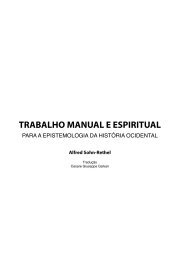Perversion the Social Relation
Perversion the Social Relation
Perversion the Social Relation
- No tags were found...
Create successful ePaper yourself
Turn your PDF publications into a flip-book with our unique Google optimized e-Paper software.
ioMolly Anne Ro<strong>the</strong>nberg and Dennis Fosterlogical repression. As he shows, Burroughs fatally undermines <strong>the</strong> politicaldream of <strong>the</strong> subversive potential of perversion by interweavingthat fantasy with evidence that, in <strong>the</strong> West, <strong>the</strong> staging of enjoymentitself serves as a primary means of social control.<strong>Social</strong> systems <strong>the</strong>mselves operate through a form of belief that has <strong>the</strong>same structure as <strong>the</strong> fetishist's disavowal, as Octave Mannoni's essay"I Know Well, but All <strong>the</strong> Same . . ." argues.* This deceptively simpleassociation provides a first step to understanding <strong>the</strong> limits of <strong>the</strong> politicallysubversive potential of perversion as well as perversion's constitutivefunctions at <strong>the</strong> limits of <strong>the</strong> social, for, as Mannoni points out,disavowal is not repression. The démystification of ideology or authoritycan serve to reinforce, at a next step, <strong>the</strong> split structure of disavowal:"I see now that X was not true, but all <strong>the</strong> same, it is true in a way." Ineffect, <strong>the</strong> démystification can serve as <strong>the</strong> springboard to consolidate<strong>the</strong> status quo: As Mannoni puts it, "Belief, shedding its imaginary form,is symbolized sufficiently to lead on to faith, that is, to a commitment,"a commitment precisely to <strong>the</strong> ideological sociocultural world.This connection between perversion and <strong>the</strong> "normal" world of socialorder transpires overtly in <strong>the</strong> realm of religious belief, as in Mannoni'sexample of <strong>the</strong> Hopi Katcina rituals. Nina Schwartz's essay, "ExoticRituals and Family Values in Exotica," gives us a deeper look into <strong>the</strong>everyday staging of perverse rituals as a means of recovering from traumaticloss and reconstituting familial relations. In a brilliant reading ofAtom Egoyan's film, Schwartz shows how <strong>the</strong> film's promise of a payoffin jouissance lures <strong>the</strong> viewer into accepting an Imaginary version of<strong>the</strong> law—<strong>the</strong> same version that emerges in <strong>the</strong> political register. At <strong>the</strong>same time, <strong>the</strong> film obscures <strong>the</strong> actual devastation jouissance wreakson social ties by emphasizing <strong>the</strong> characters' static ritualized repetitions,which makes <strong>the</strong> symbolic realm appear to be untouchable by <strong>the</strong> drive.In effect, at <strong>the</strong> level of diegesis <strong>the</strong> film presents perversion as a reparativerepetition compulsion—that is, as a neurosis—while at <strong>the</strong> level ofenunciation, it instantiates a perverse relation to <strong>the</strong> law.This imbrication of perversion and neurosis does not stem from a flawin <strong>the</strong> conception of this film but inheres in <strong>the</strong> relation between driveand desire at <strong>the</strong> level of <strong>the</strong> subject. The losses that <strong>the</strong> individual undergoesin order to emerge as a social subject never "disappear" but continueto function as propulsions toward satisfactions, propulsions that








